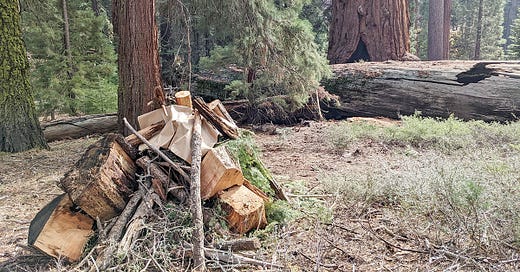Fire season is over, let the burning begin!
Land managers working to burn in giant sequoia groves
Volume 1, Number 16 - Monday, Nov. 21, 2022
A burn pile in Grant Grove, Kings Canyon National Park, November 2022. — Claudia Elliott
Perspective
I NOTICED PILES of brush and chunks of logs when my husband and I visited Sequoia and Kings Canyon national parks in early November. Just a few days later, the ground around many of the giant sequoia groves there was covered with snow. But I know that when the time is right, a drip torch will be employed to set the piles ablaze and hopefully low intensity fire will do double-duty — reduce fuel load around the big trees and create conditions conducive to giant sequoia regeneration.
At Calaveras Big Trees State Park, CalFire began prescribed burning more than a month ago. Burning projects there have been in partnership with Save the Redwoods League. I’ve written a lot about the Forest Service and National Park Service Giant Sequoia Emergency Response this year, but Save the Redwoods League has been working since before 2019 with California Climate Investments, a statewide program that funds projects with Cap-and-Trade dollars, on giant sequoia projects.
Sequoia National Forest reports that fire managers will be conducting prescribed burning projects in the Hume Lake Ranger District in Giant Sequoia National Monument.
And not only SEKI, but also Yosemite National Park is planning prescribed burns now that the weather is cooler.
These fires will necessarily mean that there will be smoke in the Sierra Nevada while these efforts are underway and some of it will drift to neighboring communities.
That’s a concern, of course, but also part of the conundrum. Before the Gold Rush, we have learned, California had far more smoke. When John Muir first saw the Yosemite Valley, researchers tell us, he did not realize that Sierra Miwok and Valley Yokuts had used fire there to manage the land for their purposes.
Today, land managers have a better understanding of the role of fire in the Sierra Nevada. But they also have millions of people living within what I’ll call the smokeshed of the prescribed burns that most everyone agrees are necessary to restore and protect the forest, including giant sequoia groves.
What do researchers say? Well, partly that more research is needed. Here’s an important article published in September in the International Journal of Wildland Fire.
From the abstract:
“Rapidly scaling up the use of prescribed fire is being promoted as an important pathway for reducing the growing damages of wildfire events in the United States, including limiting the health impacts from smoke emissions. However, we do not currently have the science needed to understand how the health impacts associated with prescribed fire smoke in the present compare to wildfire smoke exposure in the future. In particular, we lack an understanding of how the potential long-term public health benefits of prescribed fire on future wildfire smoke and health impacts compare to prescribed fire’s short-term effects on human health.”
Ramping up prescribed fire, as is planned by all of the Sierra Nevada land managers, will require ongoing public support.
Staying away from the mountains during the prescribed fire burn season is easy for those of us who live elsewhere. But for people who live in nearby communities, it’s not so easy. On the other hand, these mountain folks are also the ones who have seen first-hand the devastation caused by high intensity wildfires in recent years.
As I said, it’s a conundrum.
Did you know you can comment here?
It’s easy to comment on items in this newsletter. Just scroll down and you’ll find a comment box. You’re invited to join the conversation!
Giant sequoias in the news
• The Porterville Recorder reports that Save the Redwoods League has formed a partnership with Sequoia National Forest for stewardship and restoration of the 568-acre Long Meadow Grove which is home to the Trail of the 100 Giants and the nearby 533-acre Packsaddle Grove.
• “We got lucky.” That’s what The Los Angeles Times reports about California’s 2022 fire season. But it wasn’t just well-timed rain that helped. According to the article: “The state has responded to 7,329 fires this year — about 200 more than this time last year — despite far fewer acres burning, indicating that crews were either extinguishing blazes more quickly or halting them before they grew too large.”
• I didn’t notice this article a month ago, also from The Times. But it has an important message about why we might want to find ways to better tolerate prescribed fires. “The state’s record-breaking 2020 fire season, which saw more than 4 million acres burn, spewed almost twice the tonnage of greenhouse gases as the total amount of carbon dioxide reductions made since 2003, according to a study published recently in the journal Environmental Pollution.”
Giant sequoias around the world
There are already some large giant sequoia trees in Washington state — where the trees are not native. But someday there may be even more. Since 2019, the city of Bellevue (east of Seattle) has been planting thousands of giant sequoia trees in an effort to build climate resilience. You can read about it here and here.
Want more?
GIANTSEQUOIANEWS.COM is also a website where you can find more information about giant sequoia trees, wildfire, the public land management conundrum and more.
Thanks for reading!





It is a conundrum! Interesting about giant sequoias being planted in Washington State. I hope they will be able to thrive there.